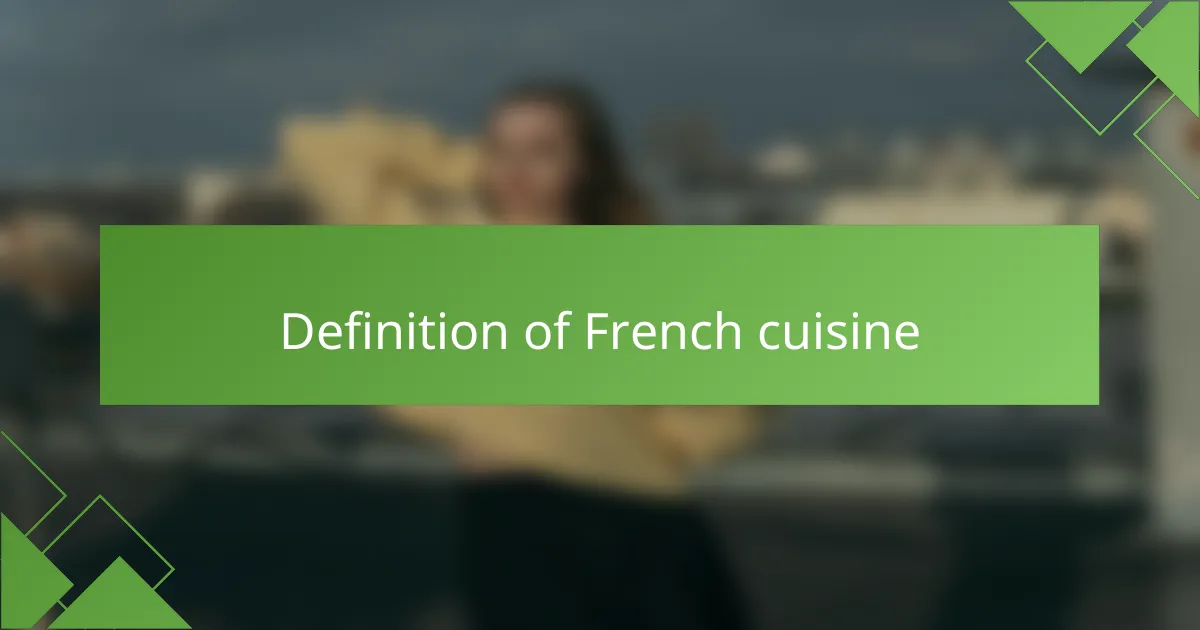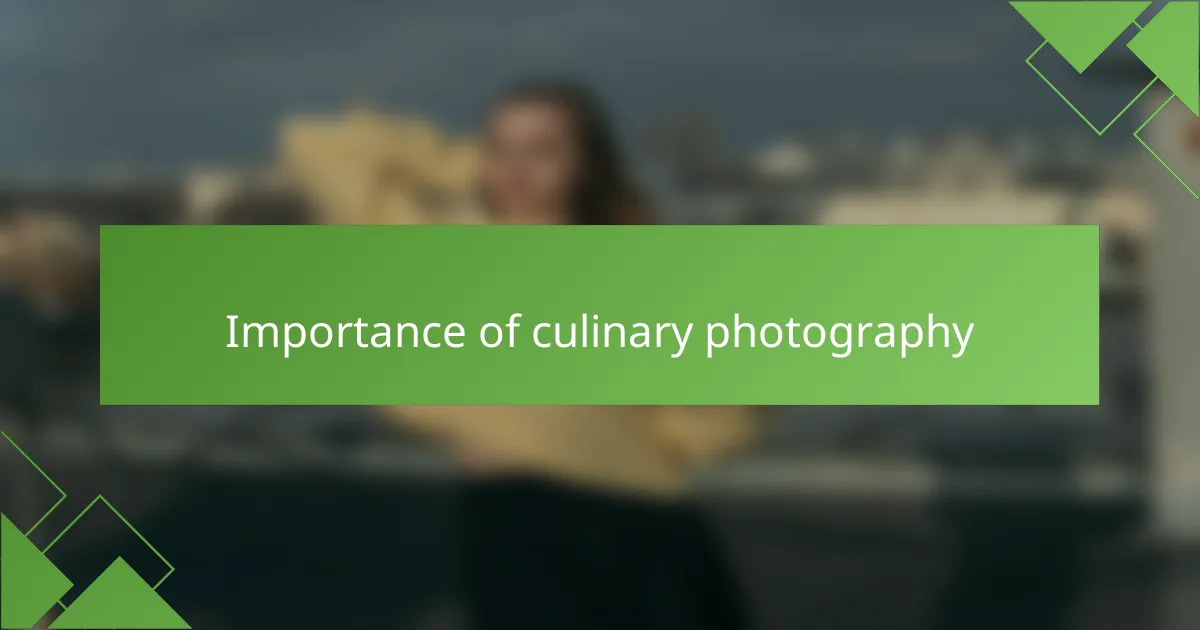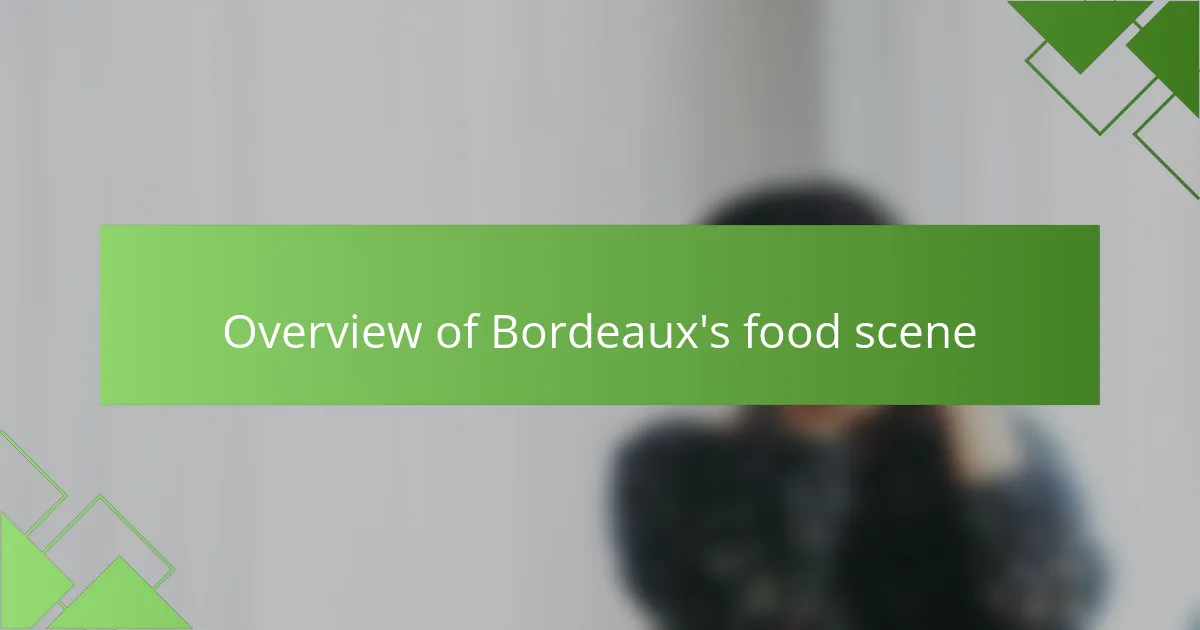Key takeaways
- French cuisine integrates culture, tradition, and regional flavors, with each dish telling a unique story.
- Culinary photography captures the artistry of cooking, evoking emotions and preserving cultural heritage.
- Bordeaux’s food scene emphasizes fresh, local ingredients and a vibrant dining atmosphere that enhances social connections.
- Documenting culinary experiences requires immersion in sensory details and engaging with local chefs for authentic narratives.

Definition of French cuisine
French cuisine is more than just food; it’s an art form that embraces culture, tradition, and regional flavors. Each dish tells a story, reflecting the geography and history of its origin. For me, documenting it in Bordeaux was like uncovering a vibrant tapestry of tastes, scents, and experiences.
As I explored local markets, I was captivated by the beauty of freshly baked baguettes and the rich aroma of herbs de Provence. Every meal I tasted felt like a celebration, inviting me to connect with the passionate people behind the recipes.
Here are some key characteristics of French cuisine:
- Emphasis on fresh, high-quality ingredients
- Regional diversity, showcasing distinct flavors and cooking styles
- Techniques that prioritize balance and presentation
- Historic foundations that influence modern interpretations
- A deep-rooted culture of dining that values both food and companionship

Importance of culinary photography
Culinary photography is much more than just snapping pictures of food; it tells a story about culture, tradition, and the artistry involved in cooking. When I was in Bordeaux, each dish I captured felt alive with history. The vibrant colors and intricate presentations not only tantalized the taste buds but also evoked emotions tied to family meals and gatherings.
Through my lens, I found that culinary photography brings out the essence of French culture. It allows viewers to experience the warmth of communal dining or the precision of a finely crafted dish. I realized that a single photograph could ignite memories or inspire someone to explore their own culinary journey, transcending the mere act of eating.
- It bridges the gap between food and art, showcasing the chef’s creativity.
- It preserves cultural heritage and fosters appreciation for regional recipes.
- Engaging visuals can evoke emotions and memories tied to specific flavors.
- It encourages culinary exploration and experimentation among viewers.
- It plays a critical role in marketing for restaurants and food businesses.

Overview of Bordeaux’s food scene
Bordeaux’s food scene is a vibrant tapestry woven from its rich historical roots and the fresh, local ingredients that define the region. I remember walking through the bustling streets, the aroma of freshly baked bread and roasted meats captivating my senses. Each bistro and market I visited offered a delightful glimpse into the region’s culinary soul, from traditional French dishes to innovative takes on seasonal produce.
Food in Bordeaux isn’t just a meal; it’s an experience. I recall sitting at an outdoor café, savoring a plate of confit de canard while the sun set over the Garonne River, witnessing the locals discussing life and food as if they were intertwined. The city’s emphasis on fresh, high-quality ingredients shines through in every bite, which is perhaps why the food scene feels so alive and engaging.
Here’s a quick comparison to highlight key aspects of Bordeaux’s food scene:
| Aspect | Description |
|---|---|
| Local Ingredients | Focus on fresh, seasonal produce sourced from surrounding farms. |
| Culinary Diversity | Mix of traditional French cuisine and modern interpretations. |
| Dining Atmosphere | Inviting bistros and cafés that encourage social interaction. |

Techniques for photographing food
Capturing food through my camera lens requires a delicate balance of light and composition. I’ve found that using natural light often brings out the vibrant colors and textures of each dish. For instance, I prefer shooting near a window during the golden hours; the soft, warm glow breathes life into the food, making a simple plate of coq au vin look almost ethereal.
Another technique I enjoy is getting up close to my subjects. Whether it’s the intricate details of a macaron or the sheen on a perfectly grilled piece of fish, macro photography reveals the artistry behind each dish. Have you ever noticed how those tiny details can spark a craving? That’s the magic I aim to convey—making people feel as if they can almost taste the dish through the photograph.
Finally, don’t underestimate the power of props and backgrounds. I often bring in rustic wooden boards or colorful textiles to create an inviting setting for my culinary shots. I remember once using an old farmhouse table as a backdrop for a variety of cheeses—its weathered texture perfectly framed the rich colors and textures of the ingredients. The right environment can elevate an image, giving it depth and context while celebrating the essence of French cuisine.

Tips for documenting culinary experiences
When documenting culinary experiences, it’s essential to immerse yourself in the atmosphere and embrace the sensory details. I remember wandering through the vibrant markets of Bordeaux, overwhelmed by the smell of freshly baked bread and ripe tomatoes. Capturing those moments added depth to my photographs, making the dishes not just food but a storyteller of the local culture.
A few practical tips can enhance your culinary documentation:
- Be Patient: Wait for the right moment to capture the dish, whether it’s the first bite of a steaming plate or the vibrant colors of fresh ingredients.
- Engage the Senses: Describe what you’re experiencing—sounds, smells, and textures—to make your documentation more immersive.
- Incorporate Personal Touches: Share your thoughts or anecdotes related to a dish; personal stories can connect viewers deeper to the cuisine.
- Experiment with Angles: Play around with different perspectives—close-ups can capture textures, while wider shots can tell the story of the dining environment.
- Interact with Chefs and Locals: Their passion and insights can add authentic layers to both your images and narrative.

Personal reflections on my journey
I cherish the memories of my culinary journey through Bordeaux. Each encounter, whether with a local chef or a market vendor, sparked a connection that transcended mere food photography. I often found myself asking, “What makes this dish special?” The heartfelt stories shared with me revealed not just recipes but the passion woven into every ingredient and preparation.
Reflecting on my experiences, I realize how pivotal it was to be present in each moment. For instance, as I sampled a perfectly crafted tart tatin, I couldn’t help but feel a wave of nostalgia wash over me. The flavors transported me back to family gatherings, where dessert was the grand finale. It’s strange how a single bite can evoke such deep, rich memories that make documenting food feel more like capturing heartfelt moments.
Photography, for me, became a bridge between my own emotions and those of the people I met along the way. I remember one evening spent sharing a meal with a family, laughing and exchanging stories over a delightful plate of oysters. That sense of belonging and warmth infused my photographs with an authenticity that goes beyond the visual—I captured relationships, traditions, and the essence of Bordeaux itself. It left me pondering: how can a mere photograph evoke such profound connections? And I found that the answer lies in the stories behind the food.

Key takeaways from my Bordeaux experience
During my time in Bordeaux, I discovered that documenting French cuisine is as much about the story as it is about the food itself. I vividly remember the warmth of a bustling market, the vibrant colors of fresh produce, and the delightful aromas wafting from local bistros. Each plate I photographed carried a piece of a chef’s passion, transforming each meal into a visual narrative that resonated with people.
Another key insight was the importance of light in food photography. Observing how natural light danced on the surfaces of a quiet café’s tart was breathtaking. I learned to appreciate the delicate interplay of shadows and highlights, which brought an entirely new dimension to my images. Ultimately, capturing this culinary journey allowed me to deepen my connection with both the food and the culture.
| Experience | Key Insight |
|---|---|
| Market Visit | Vibrant local ingredients shape authentic dishes |
| Photographing at Cafés | Natural light enhances the allure of food |